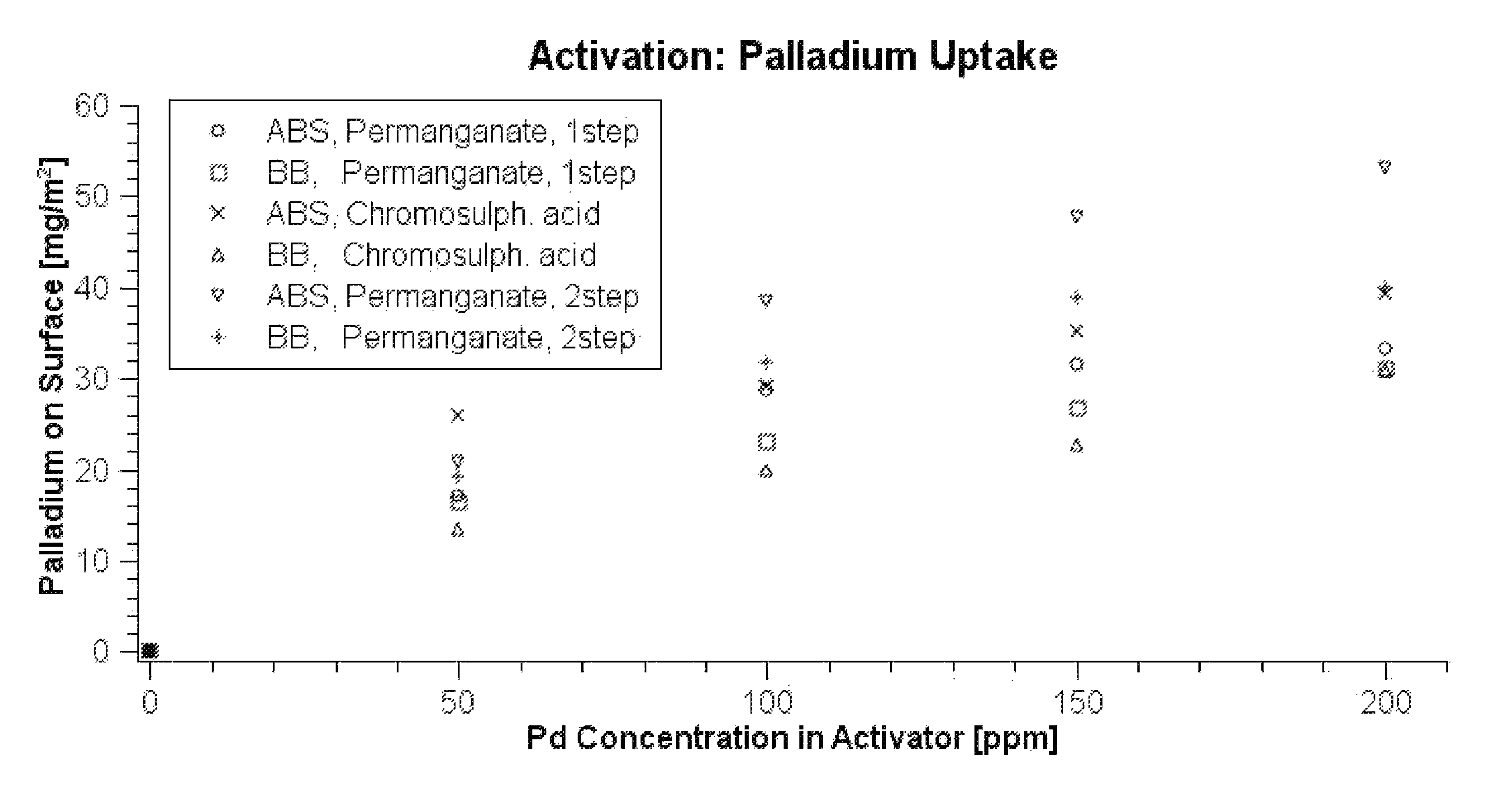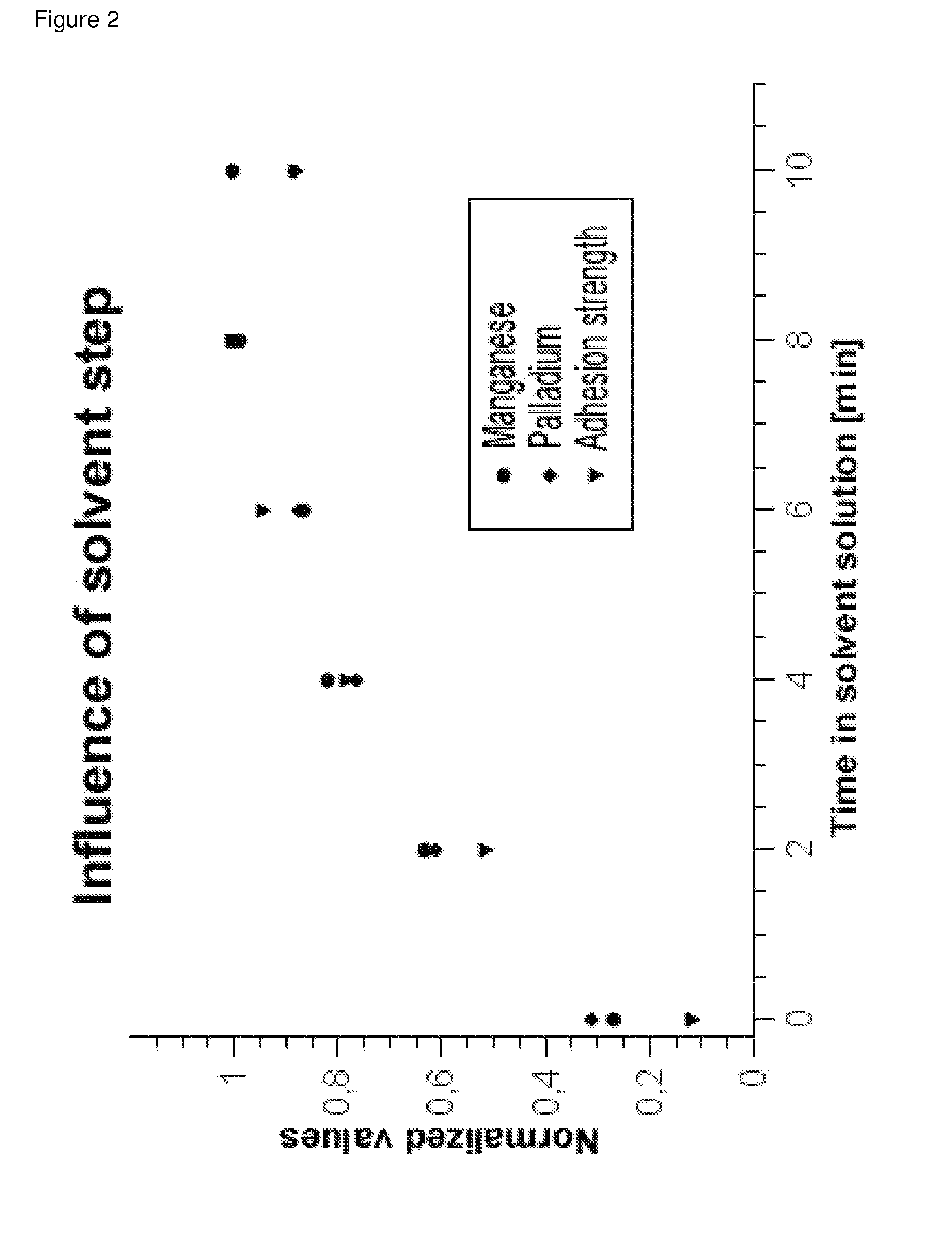Process for metallizing nonconductive plastic surfaces
a non-conductive plastic and metallizing technology, applied in the direction of metal material coating process, liquid/solution decomposition chemical coating, coating, etc., can solve the problems of unstable solution, toxic etching solution based on chromosulphuric acid, unsuitable solution of alkaline permanganate,
- Summary
- Abstract
- Description
- Claims
- Application Information
AI Technical Summary
Benefits of technology
Problems solved by technology
Method used
Image
Examples
working examples
[0167]The working examples described hereinafter are intended to illustrate the invention in detail.
example 1
Inventive Example
[0168]A panel of Bayblend T45PG (10 cm×5 cm, ABS / PC mixture) was treated in a 40% solution of 2-(2-ethoxyethoxy) ethyl acetate which had been adjusted to pH=7 with a potassium phosphate buffer at 25° C. for 7 minutes (pretreatment step). Subsequently, the panel was rinsed under running water for about one minute.
[0169]The panel was treated in an acidic permanganate solution (100 g / l NaMnO4, 10 g / l 96% H2SO4) which had been heated to 70° C. for 10 minutes. Thereafter, the panel was treated in an alkaline permanganate solution (30 g / l NaMnO4 and 20 g / l NaOH) for 10 minutes (etching treatment I., process step A)).
[0170]Thereafter, the panel had a homogeneous brown surface. Reduction with a reduction solution composed of 25 ml / l 96% sulphuric acid and 30 ml / l 30% hydrogen peroxide at 40° C. removed the manganese dioxide from the panel (process step A iii)).
[0171]After subsequent rinsing and brief preliminary dipping into a solution of 300 ml / l 36% hydrochloric acid (pro...
example 2
Inventive Example
[0176]Two panels of Bayblend T45PG (10 cm×5 cm, ABS / PC mixture) were pretreated in a solution of 2-(2-ethoxyethoxy) ethyl acetate, as described in Example 1, and then rinsed under running water for about one minute.
[0177]The two panels were designated P1 and P2. Panel P1 was treated in an acidic permanganate solution (100 g / l NaMnO4, 10 g / l 96% H2SO4) which had been heated to 70° C. for 10 minutes. Panel P2 was treated in the alkaline permanganate solution (30 g / l NaMnO4 and 20 g / l NaOH) which had been kept at 50° C. for 10 minutes. Thereafter, panel P1 was treated in the alkaline permanganate solution described for 10 minutes (etching treatment I., process step A)) and panel P2 in the acidic permanganate solution described for 10 minutes (etching treatment II., process step A)).
[0178]Subsequently, the two panels, as described in Example 1, were treated with reduction solution and preliminarily dipped. Subsequently, the panels were activated in a colloid activator b...
PUM
| Property | Measurement | Unit |
|---|---|---|
| concentration | aaaaa | aaaaa |
| concentration | aaaaa | aaaaa |
| concentration | aaaaa | aaaaa |
Abstract
Description
Claims
Application Information
 Login to View More
Login to View More - R&D
- Intellectual Property
- Life Sciences
- Materials
- Tech Scout
- Unparalleled Data Quality
- Higher Quality Content
- 60% Fewer Hallucinations
Browse by: Latest US Patents, China's latest patents, Technical Efficacy Thesaurus, Application Domain, Technology Topic, Popular Technical Reports.
© 2025 PatSnap. All rights reserved.Legal|Privacy policy|Modern Slavery Act Transparency Statement|Sitemap|About US| Contact US: help@patsnap.com



